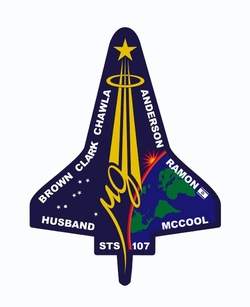STS-107 Mishap Response Status Report #1; Tuesday, February 11,
2003 - 2 p.m. CST
 Columbia debris recovery efforts continued
today centered in areas of eastern Texas and western Louisiana.
More than 1,600 recovered items are at Barksdale Air Force Base,
Shreveport, La. Barksdale is the central field collection point for
debris being shipped to the Kennedy Space Center (KSC), Fla., to
begin Shuttle Columbia reconstruction.
Columbia debris recovery efforts continued
today centered in areas of eastern Texas and western Louisiana.
More than 1,600 recovered items are at Barksdale Air Force Base,
Shreveport, La. Barksdale is the central field collection point for
debris being shipped to the Kennedy Space Center (KSC), Fla., to
begin Shuttle Columbia reconstruction.
In addition, more than 300 items are at each of the field
collection sites in Lufkin, Palestine and San Augustine, Texas,
awaiting shipment to Barksdale. A smaller volume is at Carswell
Naval Air Station in Fort Worth, Texas. Shipments of debris from
Barksdale AFB to KSC begin this week. Two truckloads of items
departed Louisiana en-route to KSC today.
No confirmed debris has been recovered west of the Fort Worth
area. Teams continue to investigate reports from 27 states and
eight jurisdictions outside of the U.S. Of 179 reports received
from California, 105 have been closed. Of 162 reports in Arizona,
eight have been closed. Of 12 reports in New Mexico, four have been
closed.
To assist recovery efforts, searchers are using Civil Air Patrol
volunteers, airborne radar and other assets. U.S. Navy assets also
may be used to search the waters of Toledo Bend and Sam Rayburn
reservoirs due to several eyewitness reports of debris entering
those lakes. The search may continue for several weeks. Civil Air
Patrol volunteers also are searching west of the Fort Worth area in
regions along Columbia's flight path.
 Preliminary identification of some debris reported
by the Mishap Investigation Team included a roughly two-foot square
section of an external tank umbilical door, a hydrazine propellant
tank and electronics equipment from the Ku-band communications
system. The Ku-band communications debris was erroneously
identified yesterday as one of Columbia's five flight
control computers, known as General Purpose Computers (GPCs). No
GPCs have been identified among recovered items. All
identifications of items are preliminary.
Preliminary identification of some debris reported
by the Mishap Investigation Team included a roughly two-foot square
section of an external tank umbilical door, a hydrazine propellant
tank and electronics equipment from the Ku-band communications
system. The Ku-band communications debris was erroneously
identified yesterday as one of Columbia's five flight
control computers, known as General Purpose Computers (GPCs). No
GPCs have been identified among recovered items. All
identifications of items are preliminary.
Still in Space, ISS Crew Handles What's Handed Them...
 On the
International Space Station, Expedition Six Commander Ken Bowersox,
NASA Station Science Officer Don Pettit and Flight Engineer Nikolai
Budarin took time out from unpacking items delivered by a
Progress-10 Russian supply craft for their first news conference
since the Columbia accident. The conference took place
about three hours after the Progress' thrusters boosted the
altitude of the station approximately 6.5 miles to an orbit of 240
x 255 miles.
On the
International Space Station, Expedition Six Commander Ken Bowersox,
NASA Station Science Officer Don Pettit and Flight Engineer Nikolai
Budarin took time out from unpacking items delivered by a
Progress-10 Russian supply craft for their first news conference
since the Columbia accident. The conference took place
about three hours after the Progress' thrusters boosted the
altitude of the station approximately 6.5 miles to an orbit of 240
x 255 miles.
Bowersox said the crew first heard of the loss of
Columbia from Johnson Space Center Director Jefferson
Howell, and the crew is being kept apprised of the status of the
accident investigation.
"My first reaction was pure shock," Bowersox said. "I was numb,
and it was hard to believe that what we were experiencing was
really happening. And then as reality wore on, we were able to feel
some sadness."
Bowersox said Mission Control has reduced the crew's schedule to
allow time for grief and reflection, and the crew was provided
ample opportunity for communication with families for emotional
support.
"We've had time to grieve for our friends, and that was very
important. When you're up here this long, you can't just bottle up
your emotions and focus all of the time," Bowersox said. "It's
important for us to acknowledge that the people on STS-107 were our
friends, that we had a connection with them, and that we feel their
loss, and each of us had a chance to shed some tears. But now, it's
time to move forward and we're doing that slowly," he said.
Willing to stay as long as it takes...
 Bowersox and Pettit said they have told Mission
Control they are willing to stay in orbit for a year or more if
necessary, and they would consider the extra time a bonus, not a
hardship. They said that if it were decided that a two-person crew
should relieve them, that crew would be kept busy maintaining
station systems but could still perform useful research.
Bowersox and Pettit said they have told Mission
Control they are willing to stay in orbit for a year or more if
necessary, and they would consider the extra time a bonus, not a
hardship. They said that if it were decided that a two-person crew
should relieve them, that crew would be kept busy maintaining
station systems but could still perform useful research.
"There would be time to do some level of research, and by virtue
of having people here, you are always doing research on your body
itself, looking at the effects of long duration, weightlessness on
the human physiology," Pettit said. "So it's important to keep
people on Station. If we could continue to collect data and life
science data in data sets for 10 or 15 year periods, it may
actually turn out to be one of the more valuable data sets we get,"
he said.
 ANN's Daily Aero-Term (12.19.25): Ultrahigh Frequency (UHF)
ANN's Daily Aero-Term (12.19.25): Ultrahigh Frequency (UHF) NTSB Prelim: Cirrus Design Corp SR22T
NTSB Prelim: Cirrus Design Corp SR22T Classic Aero-TV: The Red Tail Project--Carrying the Torch of the Tuskegee Airmen
Classic Aero-TV: The Red Tail Project--Carrying the Torch of the Tuskegee Airmen Aero-News: Quote of the Day (12.19.25)
Aero-News: Quote of the Day (12.19.25) Airborne 12.17.25: Skydiver Hooks Tail, Cooper Rotax Mount, NTSB v NDAA
Airborne 12.17.25: Skydiver Hooks Tail, Cooper Rotax Mount, NTSB v NDAA






